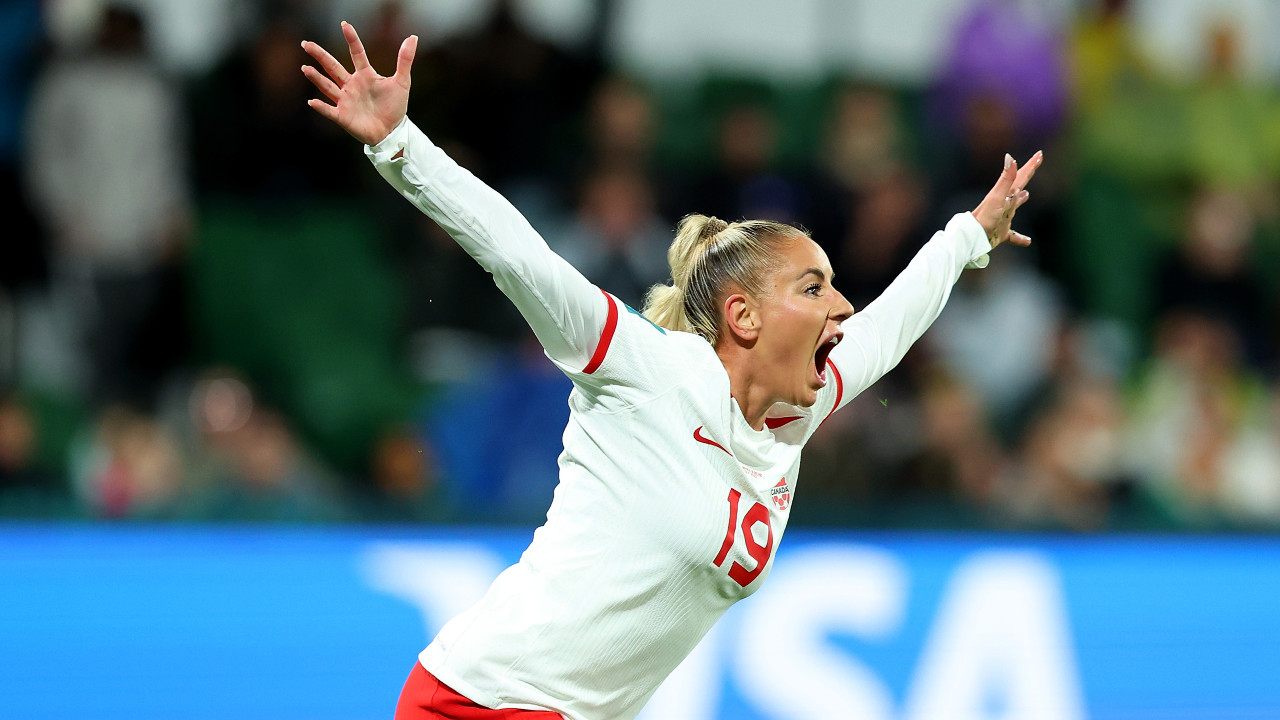
Serious questions were asked of the Canadian women’s team after it opened its FIFA World Cup campaign last week with a disappointing 0-0 draw against Nigeria.
Could Canada find a second gear after such a lifeless display? Where would the goals come from in this tournament? Is this team a genuine World Cup contender?
Wednesday’s game against the Republic of Ireland wasn’t a must-win situation for Canada. But after the stalemate against Nigeria, the Olympic champions badly needed three points in order to revive their chances of qualifying for the knockout round.
The Canadians responded with a hugely important, come-from-behind 2-1 victory in Perth, a result that revitalized their World Cup hopes and showed they should not be so easily dismissed.
Here are the three major takeaways from Canada’s win over Ireland:
A disastrous first half from Canada
It was a laborious opening 45 minutes from Canada, who looked disjointed in defence and out of sync in midfield, and who produced very little in attack with just one shot on target. With an extra bounce in its step, Ireland outplayed the Olympic champions with their aggressive attacking style and commitment to outwork their opponents in the centre of the park by continuously being the first to second balls.
The Irish stunned the Canadians by taking an early lead off a spectacular Olimpico — a goal scored directly off a corner kick. After Kailen Sheridan made a save from in close on Kyra Carusa, Irish captain Katie Mccabe’s whipped-in delivery off the ensuing corner caught the Canadian goalkeeper off guard and nestled inside the far post.
Ireland continued to carry the bulk of play, even though Canada dominated possession. The Canadians should have equalized midway through the first half when Jessie Fleming’s cross into the penalty area was headed by Kadeisha Buchanan. The ball carried on in its path towards fellow centre back Vanessa Gilles, whose stabbing attempt from six yards out just went over the crossbar.
Canada continued to drag its feet in a sluggish fashion and was unable to break down Ireland’s low defensive block. But then — out of nothing in injury time — Julia Grosso’s dangerous cross deep into the crowded box from the left wing deflected off Ireland’s Megan Connolly and into the back of the net.
Truthfully, it was far more than the Canadians deserved after a first-half performance that was downright lethargic and marked by the Olympic champions’ complete lack of urgency.
Halftime changes the turning point for Canada
Coach Bev Priestman made two changes from the Nigeria match, inserting influential midfielder Jessie Fleming (recovering from a calf injury) and forward Evelyne Viens into the starting lineup, with captain Christine Sinclair and fellow forward Deanne Rose making way.
The big news was that Fleming started in place of Sinclair and wore the captain’s armband. In the end, Canada could have used Sinclair in the first half. The Canadians lacked any kind of cutting edge in the final third of the pitch and struggled to break down Ireland’s deep defensive block.
Looking to give her team a spark, Priestman called in the cavalry by way of a triple substitution at the start of the second half. Into the match came Sinclair, veteran midfielder Sophie Schmidt, and centre back Shelina Zadorsky. They replaced Grosso, the usually reliable Buchanan (not so much on this day), and an ineffective Viens. Swapping out Grosso was a bold move considering she was one of the few players who looked lively going forward for Canada.
But all changes proved to be inspiring, and Priestman’s triple substitution was the turning point in the match and tipped the game in the Canadians’ favour. Canada suddenly had a lot more experience on the pitch (the newcomers have 635 caps between them), allowing it to create scoring chances, firmly take control of the game, and force Ireland onto the back foot.
Sinclair made an immediate impact when she prevented the ball from going out of touch and then fed a great pass to Jordyn Huitema, whose curling shot from 20 yards out forced Ireland goalkeeper Courtney Brosnan into making a diving save.
Canada poured on the pressure after Quinn did well to fight off two Irish players before getting the ball to Schmidt. The veteran midfielder played a fabulous cross into the box between two Irish defenders for Adriana Leon, who took a touch before poking it home for the winner.
Schmidt continued to drive Canada’s midfield with her box–to-box running and sublime distribution skills, Sinclair managed to get into dangerous scoring positions, and Zadorsky helped Canada effectively lock things down at the back.
A return for Sinclair to the No. 9 position
Social media was abuzz an hour before kickoff when Canada’s starting lineup was released. Much to Canadian fans’ relief, Jessie Fleming was back in the starting 11. But in a surprising move, Bev Priestman had Christine Sinclair on the bench for this hugely important match.
Priestman’s decision meant that Sinclair did not start for Canada for the first time in 23 World Cup games across six tournaments. The last time the Canadian team played without Sinclair in the starting lineup at the World Cup came at the 1999 competition.
Sinclair is the all-time leading scorer in international soccer, for both men and women, with 190 goals. She had started all 22 of her previous World Cup matches, scoring 10 goals along the way. The veteran forward also started 82 of her previous 87 games overall for Canada going back to 2016.
But with Fleming back, Priestman decided to deploy her as the team’s chief playmaker in the middle of its attacking trio playing behind the main striker, in this case Viens. It’s a role that the 40-year-old Sinclair has taken up over the last several years, as it allows her to be more involved with Canada’s buildup play.
But against Ireland, Sinclair replaced Viens in her more familiar No. 9 role at the start of the second half, serving as the main reference point up top, like she has for so many years.
Having Sinclair return to her more traditional position paid off handsomely for Priestman. With the veteran forward leading the line, Canada recorded six shots on target in the second half, after being limited to just one through the first 45 minutes.
Sinclair’s presence up front gave Ireland’s back line all kinds of fits, as the Canadian forward routinely found herself in dangerous positions in and around the box and had three good looks on goal that she didn’t convert. Her deft touch and sound holdup play also allowed her to effectively link up with Jordyn Huitema and create scoring opportunities for her fellow forward and other teammates.
John Molinaro is one of the leading soccer journalists in Canada, having covered the game for over 20 years for several media outlets, including Sportsnet, CBC Sports and Sun Media. He is currently the editor-in-chief of TFC Republic, a website dedicated to in-depth coverage of Toronto FC and Canadian soccer. TFC Republic can be found here.






